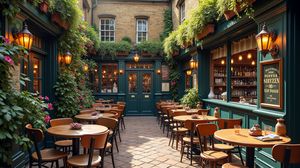
The Royal Court Theatre, nestled in the heart of Sloane Square, is a jewel in the crown of London's theatrical scene. Known for its bold and innovative programming, the theatre has a rich history dating back to its establishment in 1870. It has long been a champion of contemporary playwrights, making it a revered platform for new writing.
Over the years, The Royal Court Theatre has been a springboard for a multitude of groundbreaking plays and famous names in the theatre industry. It famously premiered John Osborne's 'Look Back in Anger' in 1956, which is credited with revolutionizing British theatre and giving rise to the term "kitchen sink drama".
The theatre is known for its commitment to nurturing new talent, often hosting debut works by now-renowned playwrights. This commitment extends to its outreach and education programs, which engage with the wider community and foster new voices in drama.
The structure itself is an intriguing blend of Victorian architecture and modern renovations. The auditorium underwent a major refurbishment in the 1990s, which modernized its facilities while retaining its historic charm, offering visitors a unique blend of past and present.
An interesting quirk of The Royal Court Theatre is that it's often seen as a breeding ground for controversy. It has not shied away from tackling taboo or divisive topics in its repertoire, earning a reputation for not only engaging but also challenging audiences. This aspect of the theatre makes each visit an intellectually stimulating experience.
Actors and directors of international calibre frequently grace the stage at The Royal Court, adding a touch of glamour and prestige. The theatre's daring approach extends offstage as well, with its bar and restaurant providing a lively cultural hub for artists and audiences alike to mingle and discuss the productions.

Making the Most of Your Visit:
Arrive a bit early if you can, and take a leisurely stroll around the local streets. Sloane Square is surrounded by charming boutiques and historic architecture, making for a pleasant pre-theatre experience.
If you're a fan of contemporary theatre, check the programme for post-show talks. These events often feature directors, writers, and sometimes actors discussing the play, offering unique insights that you won't get just by watching the performance.
The theatre's Upstairs and Downstairs distinction isn't just about location; the two spaces often offer different vibes and play styles. If you're in the mood for an intimate, experimental piece, head to the smaller Upstairs theatre.
Have a drink at the theatre's bar. It's not just a place to enjoy a pre-show tipple but also a space where you might bump into creatives and audience members buzzing from the show. The lively discussions are often as spirited as the performances themselves.
Keep an eye out for small exhibitions and displays within the theatre's space. They often showcase the history of the plays and the artistic process, adding layers of context to your theatre experience.

Visiting Times & Costs:
The Royal Court Theatre, located at Sloane Square, is open to the public throughout the year, except on certain holidays. It typically operates from late morning into the evening, aligning with performance schedules. However, timings can vary, especially for matinee or special performances, so it's advisable to check in advance for specific opening hours.
Admission Costs:
- The general admission fee varies depending on the performance. Standard ticket prices range from affordable options to premium seats, with occasional discounts available for concessions, including students and seniors.
- The theatre's public areas such as the bar and foyer are free to access, allowing visitors to enjoy the atmosphere without attending a performance.
Accessibility:
- The Royal Court is committed to accessibility, offering facilities for those with disabilities. This includes wheelchair access and accessible toilets. Assistance dogs are welcome, and hearing assistance devices are available.
- It is recommended to contact the theatre in advance to discuss specific needs, ensuring a smooth and accommodating visit.

Address & Map:

Nearby:























